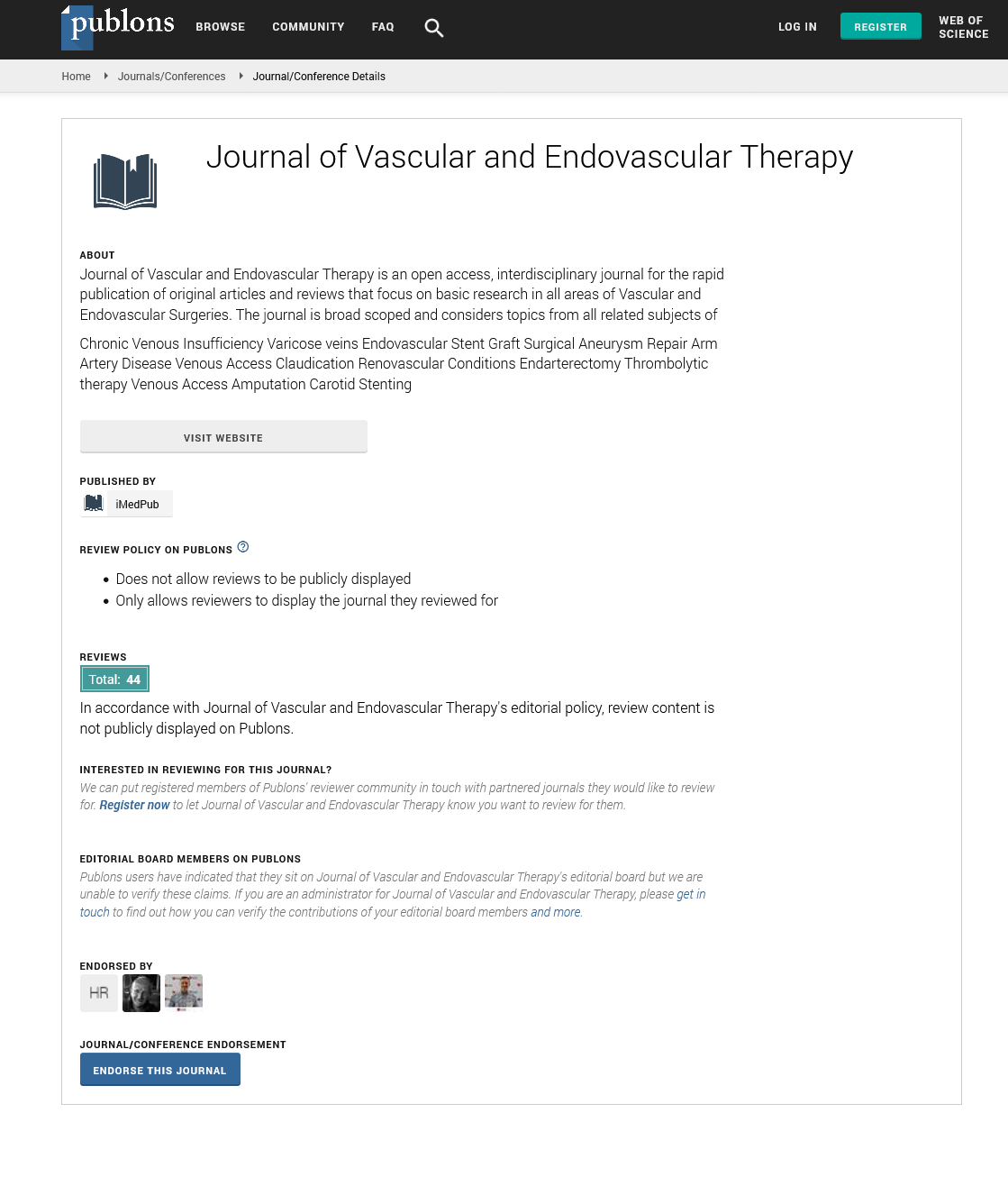ISSN : 2634-7156
Journal of Vascular and Endovascular Therapy
Atorvastatin enhances paracrine proangiogenic activity of hematopoietic stem/progenitor derived cells in vitro but not in vivo
3rd Edition of World Congress & Exhibition on Vascular Surgery
May 24-25, 2018 London, UK
Witold N Nowak, Hevidar Taha, Joanna Markiewicz, Neli Kachamakova Trojanowska, Urszula Florczyk Soluch, Jozef Dulak and Alicja Jozkowicz
Jagiellonian University, Poland
Posters & Accepted Abstracts: J Vasc Endovasc Therapy
DOI: 10.21767/2573-4482-C1-003
Abstract
Circulating proangiogenic cells (PACs), were described as bone marrow-derived cells that can contribute to angiogenesis and even de novo blood vessel formation. Number and function of PACs are impaired in patients with diabetes or cardiovascular diseases. Both diseases can be accompanied by decreased levels of heme oxygenase-1 (HMOX1), cytoprotective, heme-degrading enzyme, which is crucial for PAC function in mouse models. Therefore, our study aimed to check whether pharmacological enhancement of HMOX1 expression in hematopoietic stem/progenitor (HSPC) derived PAC cells would improve their paracrine proangiogenic activity. We used GCSF-mobilized CD34+ cells, FACS-sorted from a healthy donor PBMCs. Sorted cells were CD45dimCD90CD105-CD181- and predominantly CD133+ and CD11b-. CD34+ cells after six days in culture were stimulated with atorvastatin, acetylsalicylic acid, sulforaphane, resveratrol or metformin for 48 h. Conditioned media from such cells were then used to stimulate human aortic endothelial cells (HAoEC) to enhance tube-like structure formation in Matrigel assay. The only stimulant that enhanced PAC paracrine angiogenic activity was atorvastatin. On the other hand, the only one that induced heme oxygenase-1 expression was sulforaphane, a known activator of HMOX1 inducer – NRF2. Moreover, none of the stimulants changed the levels of 30 cytokines and growth factors tested with the multiplex test. Then, we used atorvastatin-stimulated cells or conditioned media from them in the Matrigel plug in vivo angiogenic assay. Neither atorvastatin alone in control media nor conditioned media nor AT-stimulated cells affected numbers of endothelial cells in the plug or plug’s vascularization. Concluding, atorvastatin can enhance the paracrine angiogenic activity of human CD34+ HSPC-derived PAC cells in vitro, but the effect was not observed in vivo. Moreover, the enhancement of HMOX1 expression with sulforaphane does not influence PAC proangiogenic action in vitro. Recent Publications
1. Xie Y, Potter C M F, Le Bras A, Nowak W N, Gu W, Bhaloo S I, Zhang Z, Hu Y, Zhang L and Xu Q (2017) Leptin induces Sca-1+ progenitor cell migration enhancing neointimal lesions in vessel-injury mouse models. Arteriosclerosis, Thrombosis, and Vascular Biology 11:2114-2127. 2. Nowak W N, Taha H, Kachamakova Trojanowska N, Stepniewski J, Markiewicz J A, Kusienicka A, Szade K, Szade A, Bukowska Strakova K, Hajduk K, Klóska D, Kopacz A, Grochot Przeczek A, Barthenheier K, Cauvin C, Dulak J and Jozkowicz A (2017) Murine bone marrow mesenchymal stromal cells respond efficiently to oxidative stress despite the low level of heme oxygenase 1 and 2. Antioxidants and Redox Signal doi: 10.1089/ ars.2017.7097. 3. Langrzyk A, Nowak W N, St├?┬?pniewski J, Ja├?┬║wa A, Florczyk-Soluch U, Józkowicz A and Dulak J (2017) Critical view on mesenchymal stromal cells in regenerative medicine. Antioxidants and Redox Signal doi: 10.1089/ars.2017.7159. 4. Januszek R, Mika P, Nowobilski R, Nowak W, Kusienicka A, Klóska D, Maga P and Ni├?┬╝ankowski R (2017) Soluble endoglin as a prognostic factor of the claudication distance improvement in patients with peripheral artery disease undergoing supervised treadmill training program. Journal of the American Society of Hypertension 11:553-564. 5. Kokkinopoulos I, Wong M M, Potter C M F, Xie Y, Yu B, Warren D T, Nowak W N, Le Bras A, Ni Z, Zhou C, Ruan X, Karamariti E, Hu Y, Zhang L and Xu Q (2017) Adventitial SCA-1+ progenitor cell gene sequencing reveals the mechanisms of cell migration in response to hyperlipidemia. Stem Cell Reports 9:681-696.
Biography
Witold N Nowak is a Biochemist and Molecular Biologist. He has expertise in isolation and characterization of human and mouse progenitor cells. In collaboration with Jagiellonian University Medical College, he showed changes in populations of circulating stem and progenitor cells in patients with type
2 diabetes and its complications or in patients with intermittent claudication subjected to treadmill training. His recent interests focus on the regulation of cellular metabolism in aging blood vessels and during the atherosclerosis progression. Email:witold.nowak@uj.edu.pl
Google Scholar citation report
Citations : 177
Journal of Vascular and Endovascular Therapy received 177 citations as per Google Scholar report
Journal of Vascular and Endovascular Therapy peer review process verified at publons
Abstracted/Indexed in
- Google Scholar
- Open J Gate
- Publons
- Geneva Foundation for Medical Education and Research
- Secret Search Engine Labs
Open Access Journals
- Aquaculture & Veterinary Science
- Chemistry & Chemical Sciences
- Clinical Sciences
- Engineering
- General Science
- Genetics & Molecular Biology
- Health Care & Nursing
- Immunology & Microbiology
- Materials Science
- Mathematics & Physics
- Medical Sciences
- Neurology & Psychiatry
- Oncology & Cancer Science
- Pharmaceutical Sciences
